Tratamento adjuvante para paralisia facial de Bell com laser de baixa intensidade: relato de caso
##plugins.themes.bootstrap3.article.main##
Resumo
Objetivo: Apresentar um relato de caso sobre o uso da Terapia com Laser de Baixa Intensidade (LLLT) como um método complementar ao uso de corticosteroide e fisioterapia para o cuidado de paciente com paralisia de Bell. Detalhamento de caso: Este estudo trata de um relato de caso em que o paciente G.G.S.S., sexo masculino, 20 anos, compareceu à Clínica de Laser da Universidade Federal de Sergipe (UFS), previamente diagnosticado com Paralisia de Bell, e devidamente medicado (prednisolona, lacrimaplus e regencel). O paciente então, foi encaminhado para fisioterapia (10 sessões) e para iniciar imediatamente o seguinte protocolo com a laserterapia (10 sessões, duas vezes por semana, usando Laser DMC Therapy EC, 808nm, 100mW, 6J e 60seg/ponto). Considerações finais: O uso do laser de baixa potência associado a outras terapias, em pacientes com Paralisia de Bell, mostrou-se efetivo em reverter completamente todos os sinais e sintomas da referida patologia, em um curto espaço de tempo.
##plugins.themes.bootstrap3.article.details##
Copyright © | Todos os direitos reservados.
A revista detém os direitos autorais exclusivos de publicação deste artigo nos termos da lei 9610/98.
Reprodução parcial
É livre o uso de partes do texto, figuras e questionário do artigo, sendo obrigatória a citação dos autores e revista.
Reprodução total
É expressamente proibida, devendo ser autorizada pela revista.
Referências
2. ALYASSIRI AM, ZAIDAN TF. Comparison between the beneficial Effects of Low Level Laser Therapy (Diode Laser) and Transcutenous Electrical Nerve Stimulation in Recovery of Patients with Bell’s palsy. Indian Journal of Forensic Medicine and Toxicology, 2019; 13(1): 332.
3. AMAROLI A, et al. Photobiomodulation and oxidative stress: 980 nm diode laser light regulates mitochondrial activity and reactive oxygen species production. Oxid. Med. Cell Longev, 2021.
4. BURELO-PEREGRINO EG, et al. Efficacy of electrotherapy in Bell's palsy treatment: A systematic review. J Back Musculoskelet Rehabil. 2020; 33(5): 865-874.
5. DALRYMPLE SN, et al. Bell palsy: Rapid Evidence Review. Am Fam Physician, 2023; 107(4): 415-420.
6. HECKMANN JG, et al. The diagnosis and treatment of idiopathic facial paresis (Bell’s palsy). Deutsches Ärzteblatt Int, 2019; 116: 692-702.
7. JAVAHERIAN M, et al. Efficacy of low-level laser therapy on management of Bell’s palsy: a systematic review. Lasers Med Sci, 2020 Aug; 35(6): 1245-1252.
8. KANDAKURTI PK, et al. The effectiveness of low-level laser therapy combined with facial expression exercises in patients with moderate-to-severe Bell's palsy: A study protocol for a randomised controlled trial. Int J Surg Protoc, 2020 Nov 14; 24: 39-44.
9. KHAN AJ, et al. Physical therapy for facial nerve paralysis (Bell’s palsy): An updated and extended systematic review of the evidence for facial exercise therapy. Clin Rehabil, 2022 Nov; 36(11): 1424-1449.
10. KIM Y, et al. Steroids plus antiviral agents are more effective than steroids alone in the treatment of severe Bell’s palsy patients over 40 years of age. International Journal of Immunopathology and Pharmacology. 2021; 35.
11. KLINE LB, et al. Bell palsy. JAMA, 2021; 326(19): 1983.
12. KUMAR S. Effect of class IV LASER on Bell’s palsy: A case series. Indian J. Phys. Ther. Res., 2019; 1: 55-58
13. KUZMIČIĆ S, et al. Chronic Bell’s Palsy literature review and case report: Are there any rehabilitation strategies available? Hrvatski časopis zdravstvenih znanosti, 2022; 2(1): 59-63.
14. MERIGO E, et al. Photobiomodulation therapy in oral medicine: a guide for the practitioner with focus on new possible protocols. Photobiomodulation, Photomedicine, and Laser Surgery, 2019; 37(11).
15. PASQUALE C, et al. Recovery from Idiopathic Facial Paralysis (Bell’s Palsy) Using Photobiomodulation in Patients Non-Responsive to Standard Treatment: A Case Series Study. Photonics, 2021; 8: 341.
16. PRUD’HON S, KUBIS N. Bell’s palsy. La Revue de Médecine Interne, 2019; 40(1): 28-37.
17. RAVERA S, et al. Mitochondrial bioenergetic, photobiomodulation and trigeminal branches nerve damage, what’s the connection? A review. Int. J. Mol. Sci., 2021; 22: 43.
18. SANCHEZ A, et al. Facial paralysis: timing of repair and management of the nonfaccidly paralyzed face. Curr Opin Otolaryngol Head Neck Surg, 2021; 29(4): 265-270.
19. SHOKRI T, et al. Tendências no tratamento da paralisia de Bell. Facial Plast Surg, 2020; 36(5): 628-634.
20. SILVA MS, et al. Low-intensity LED therapy in facial paralisys: Case report. J Braz Coll Oral Maxillofac Surg. 2021 Jan-Apr; 7(1): 61-7.
21. TANGANELI JPC, et al. Complete and Fast Recovery from Idiopathic Facial Paralysis Using Laser-Photobiomodulation. Case Rep Dent, 2020 Mar 11; 2020: 9867693.
22. TAVARES ADC, et al. Intervenção fisioterapêutica no tratamento de paciente com paralisia facial periférica: estudo de caso.Saúde e Pesquisa, 2018.
23. YILMAZ NDS, et al. Seasonal distribution of the incidence of Bell’s palsy. Medicine Science International Medical Journal, 2019.
24. YOO MC, et al. Evaluation of actors associated with favorable outcomes in adults with Bell palsy. JAMA Otolaryngol. Head Neck Surg, 2020; 146: 256-263.
25. ZHANG W, et al. The etiology of Bell’s palsy: a review. J Neurol, 2020; 267.

